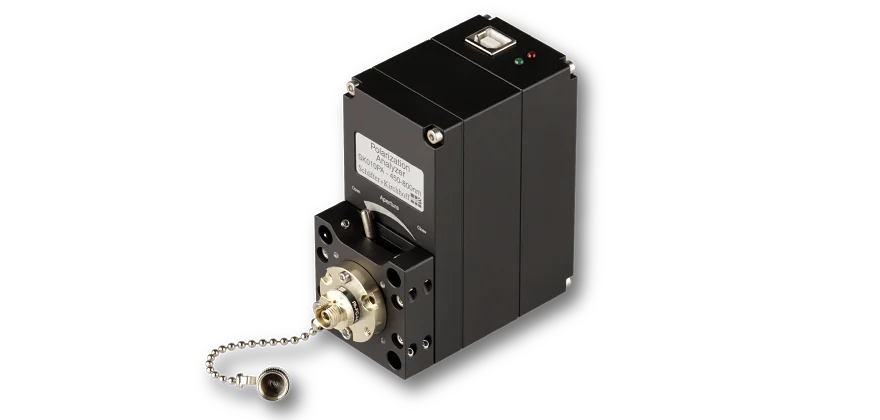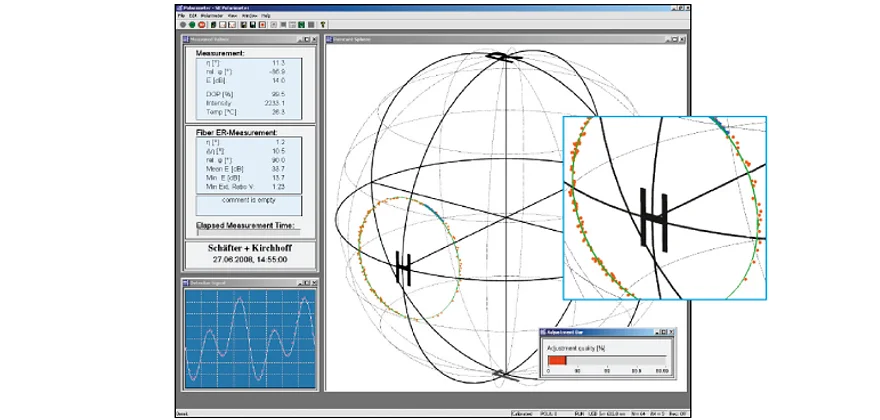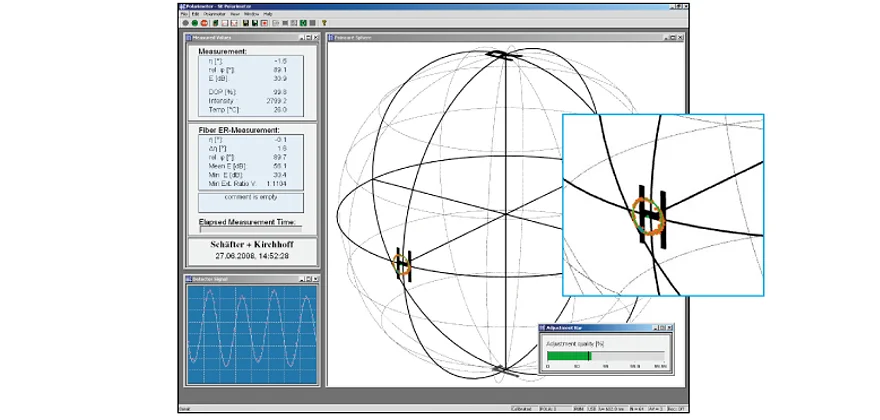The polarization analyzer can also be used for setting a well-defined state of polarization for free-beam applications. For these type of measurements, a correct alignment of the laser beam axis with the polarization analyzer is essential. This can be done using the microbench, or 40 mm cage system and using the connection with 4 rods or the rail system.
Polarization Alignment for coupling into polarization-maintaining fibers

The SK010PA Polarization Analyzer provides procedures for the alignment of the incoming polarization direction of the source with the polarization axes of the fibers and for the measurement of the resulting Polarization Extinction Ratio (PER).
Polarization-maintaining single-mode fibers guide coupled radiation in two perpendicular principle states, the fiber polarization axes (also called the slow and fast axis, see figure on the left). More information on how Schäfter+Kirchhoff characterizes PM fibers can be found here.

The polarization extinction ratio PER of fiber-coupled radiation is the ratio between the optical power levels coupled to the two polarization axes of the fiber. The Polarization Analyzer is used to optimize the polarization alignment of the polarization axis of the light source to the polarization axis of the fiber by rotating the input polarization axis of the source, see figure on the left.
For the two polarization axes the speeds of propagation are different. When a linearly polarized radiation is not coupled exactly into one of these states, the radiation is split up in two perpendicular components coupled to the polarization axes of the fiber, respectively. At the fiber exit the difference of propagation speed causes a phase shift which also depends on the length of the fiber. If this phase shift is smaller than the coherence length of the laser source, the radiation recombines to an elliptical polarization state.
If the coherence length of the laser source is smaller than the phase shift the emerging radiation is partly depolarized. The polarization analyzer supports adjustment for both cases.

The Polarization Analyzer SK010PA
More information about technical detailss can be found on the product page.

Adjustment using the Poincaré sphere

Step 1 Measurement of the initial alignment
The procedure starts with the recording of exit polarization states while the temperature is changed, or the fiber is carefully bended, to cause the exit polarization to fluctuate. A circle is then automatically fitted to the data points, and the mean and minimal PER are displayed . In the example shown, the circle on the Poincaré sphere has a large radius.

Step 2 Real-time adjustment with feedback and final measurement of the optimized alignment
During continuous measurement of the exit polarization state, the fiber axis is then rotated with respect to the polarization axis of the laser source. The optimum alignment is reached when the exit polarization state approaches the circle center on the Poincaré sphere as far as possible. A color-coded logarithmic bar plot helps to find the minimum distance.
A second measurement then reveals the parameters of the optimized polarization alignment of the fiber.
Adjustment with DOP Ellipse
If the coherence length of the laser source is smaller than the phase shift caused by the difference in propagation speed then the light is partly depolarized and adjustment is done using the DOP ellipse.

As mentioned above, recombination to an elliptical polarization state is only possible, if the coherence length of the laser source is larger than the phase shift caused by the difference in propagation speed. If the coherence length of the laser source is smaller than the phase shift caused by the difference in propagation speed then the light is partly depolarized and this is not possible.
The described circle on the Poincaré sphere cannot be observed- all exit polarization states lie on a single spot. Instead, the misalignment solely results in a reduced degree of polarization (DOP).
In this case the DOP-ellipse representation is used for fiber alignment, where a polarization measurement with a rotating linear polarizer is simulated. The DOP-ellipse (dotted line) becomes a circle for fully depolarized light.
The narrower the DOP-ellipse becomes, the better the incoming polarization axis is aligned to one of the polarization axes of the fiber. For an ideal alignment the ellipse would degrade to a line.
Free Beam Measurements
Adjustment and Quantifying of Quarter-Wave Plates

The SK010PA Polarization Analyzer can be used to align and quantify retardation optics, e.g. fiber collimators with integrated quarter-wave plates series 60FC-Q.
For these collimators, the outcome polarization is adjusted by rotating the quarter-wave plate with a special tool. A full rotation corresponds to a figure-of-eight on the Poincaré sphere. Circularly polarized light is set when the poles are reached, with right-handed circular polarization located at the north pole, and left-handed polarization located at the south pole. If the actual retardation of the optics deviates from the desired value then the extreme values do not reach the poles. The polarization analyzer thus provides a measure of the actual retardation of the optics.